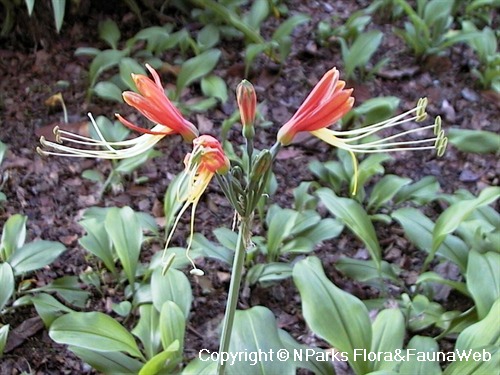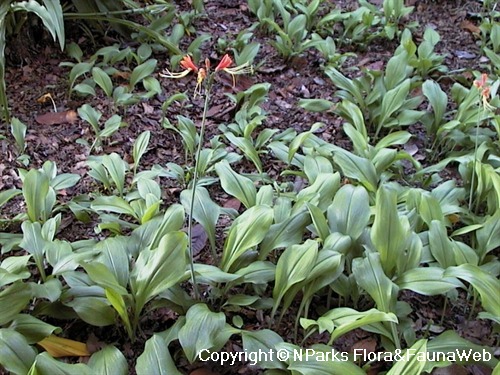
Back
Eucrosia bicolor
| Family Name: | Amaryllidaceae |
| Synonyms: | Eucrosia lehmannii |
| Common Name: | Peruvian Lily |
Name
Classifications and Characteristics
| Plant Division | Angiosperms (Flowering Seed Plants) (Monocotyledon) |
|---|---|
| Plant Growth Form | Shrub |
| Lifespan (in Singapore) | Perennial |
| Mode of Nutrition | Autotrophic |
Biogeography
| Native Distribution | Peru |
|---|---|
| Native Habitat | Terrestrial |
| Preferred Climate Zone | Tropical |
| Local Conservation Status | Non-native |
Description and Ethnobotany
| Growth Form | A fast-growing shrub from bulbs and produces plenty of leaves. |
|---|---|
| Foliage | Leaves are green, elliptical to lanceolate in shape, margin slightly undulate; midribs are large, succulent, pale green; petioles are about 12 cm long, pale and glaucous green, succulent. |
| Flowers | Inflorescence, umbel; pedicels are spreading and nearly straight, measuring about 3 cm long; corolla red in colour, lanceolate shaped; filaments are yellowish, awl-shaped, unequal and come in pairs; stigma small and nearly white in colour. |
| Etymology | The genus Eucrosia means well-fringed, which refers to the stamens. The specific epithet bicolor means two-colours, which refers to the flower colours, red and orange. |
Landscaping Features
| Desirable Plant Features | Ornamental Flowers |
|---|---|
| Landscape Uses | Parks & Gardens, Small Gardens |
Plant Care and Propagation
| Light Preference | Semi-Shade |
|---|---|
| Water Preference | Lots of Water |
| Rootzone Tolerance | Moist Soils |
| Propagation Method | Division |
Foliar
| Foliage Retention | Evergreen |
|---|---|
| Mature Foliage Colour(s) | Green |
| Mature Foliage Texture(s) | Smooth |
| Foliar Shape(s) | Non-Palm Foliage (Lanceolate, Elliptical) |
| Foliar Margin | Entire - Wavy / Undulate |
| Leaf Area Index (LAI) for Green Plot Ratio | 3.5 (Shrub & Groundcover - Monocot) |
Floral (Angiosperm)
| Flower & Plant Sexuality | Bisexual Flowers |
| Flower Colour(s) | Red |
|---|---|
| Flower Grouping | Cluster / Inflorescence |
| Inflorescence Type | Umbel |
Image Repository
Others
| Master ID | 699 |
|---|---|
| Species ID | 1994 |
| Flora Disclaimer | The information in this website has been compiled from reliable sources, such as reference works on medicinal plants. It is not a substitute for medical advice or treatment and NParks does not purport to provide any medical advice. Readers should always consult his/her physician before using or consuming a plant for medicinal purposes. |

